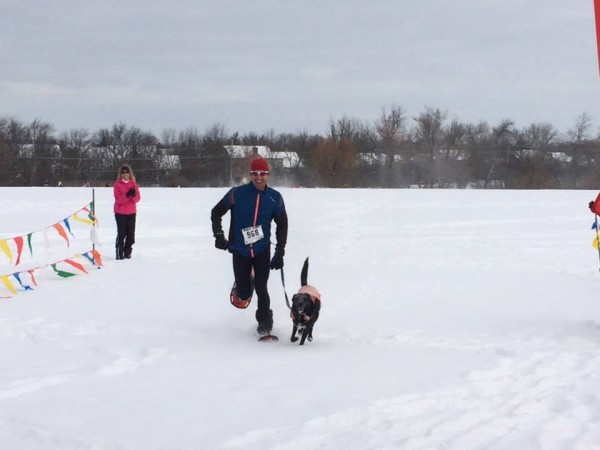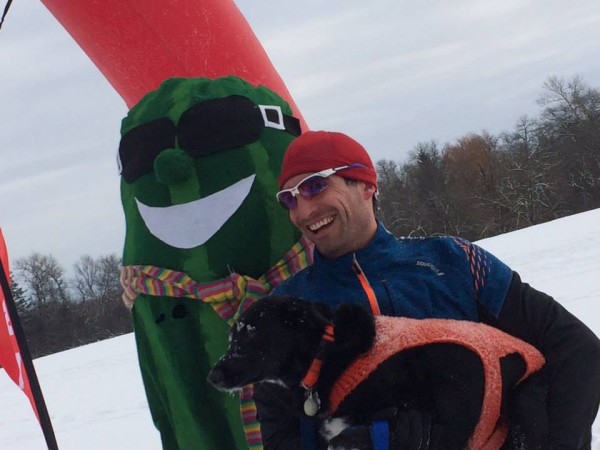When triathlete Brad Zoller lived in Chicago, he used to run the stairs to his apartment twice a week. He lived on the 23rd floor, and it took him about two minutes.
“I would take the elevator down, and then just run up the stairs,” he shares. “I would do that about six times through, about twice a week, and it was a really good workout.”
Now, as a resident of Avon, Colo., Zoller does his vertical training on mountains instead of stairs. Uphill intervals in any form, he says, are great for snowshoe race training. “It builds strength and cardio, and it’s actually a really, really good workout for snowshoeing because you’re lifting your legs a lot,” he says of the stair workouts.
A crew team member in high school and an off-road triathlete since, this endurance athlete competes in snowshoe racing as less regimented, off-season training.
“One thing about snowshoe racing, actually what I like about it — more than just regular road running — is it’s a lot like trail running where it requires strength,” he explains.

Brad Zoller with his training partner, Senna, in Barrington, IL, for the Frozen Zucchini 5k snowshoe race. Photo courtesy of Brad Zoller.
Some of the links in this article may contain affiliate links. When you make a purchase using these links, part of the proceeds go to Snowshoe Mag. Additionally, as an Amazon Associate, we earn from qualifying purchases. Please see our disclosure for more details.
So, how does he train for snowshoe racing?
“Running in snow is good, but that’s pretty obvious,” he said. “But in the winter, I don’t do too many specific workouts, just because the weather is always changing. I have to be pretty adaptive with what I do because I don’t like training inside. It’s good to let Mother Nature choose your workouts.”
Here are some of Zoller’s training tips and recommendations for taking your fitness onto the snow through snowshoe racing.
Get A Training Partner
Having someone to keep you accountable and challenge you during your workouts is important to keep training on pace. For Zoller, it’s his dog, Senna, a border collie mix, who plays that role.
“Having a training partner is probably one of the best things, for me at least,” he says. “And that’s why my dog’s so good because she can outrun me no matter what sport I’m doing.”
To find a partner, start with friends, family, or a pet. Race directors may have recommendations, or you could ask a fellow workout enthusiast in your gym class. Finally, you can also look to snowshoeing clubs in your area, Facebook groups, apps such as Meetup.com or Nextdoor to meet others.

Brad Zoller with his training partner, Senna, last year in Barrington, IL for the Frozen Zucchini 5k snowshoe race. Photo courtesy of Brad Zoller.
Build Your Strength
One training tip for snowshoe racing that Brad shared with us relates to building your strength. For example, stairs and hill training will get you ready for the snowshoe races, particularly because of the leg strength you are building while upping your cardio. Stairs running, above all, Zoller says, simulates snowshoe running in the mountains really well.
Hit the stairs, or hills, for interval training twice a week. Intervals are short sessions (between 1 to 5-minute spurts, for up to 20 total minutes) of high-heart rate work.
Read More: 7 Exercises You Can Do To Support Your Snowshoeing
Diversify Your Endurance
Lateral movement training is important to keep you agility-ready and injury-free. While you’re pumping up your endurance levels, incorporate cross-training methods like skate skiing, downhill skiing on moguls, and snowboarding.
“Skate skiing is really helpful because there’s a lot of lateral work, and you never really know what you are going to step on or run into,” explains Zoller. “It’s great to have that lateral stability there to hold you in place because you definitely slide a lot running on snow and ice.”
Read More: Building And Maintaining Endurance For Snowshoeing
Play With Gear
While many competitive snowshoe runners have their running shoes directly mounted on their snowshoes (with no bindings necessary), Zoller says he runs in Northern Lights Elite snowshoes.
“I have heard the direct mount is very helpful, but I still like to snowshoe with my wife and not have my snowshoes specifically for running,” he shares. “These that I use seem to work just fine because they are light and hold the snow well.”
You also don’t have to always train with snowshoes on. You can run on packed or groomed trails with snow spikes or Yaktrax for training, too, because a lot of running in snowshoes can lead to overuse injuries, like in the hip flexors, for instance.
Go Race!
Like all successful workouts, it’s best if you have fun while you’re doing them.
“In the winter, I can do snowshoe racing, and it’s fun and great cross-training, and I love it,” says Zoller. For more info from Brad Zoller, follow him on his website.
What other training tips do you have for snowshoe racing? Please share them with us in the comments below.
This article was first published on Jan 12, 2015, and was updated to include new information on November 24, 2020.
Read Next:
Transition From Running To Snowshoe Racing
10 Unwritten Rules of Snowshoe (and Trail) Racing
Pump Up Your Iron With Advice From Registered Dietitian



Leave a Comment